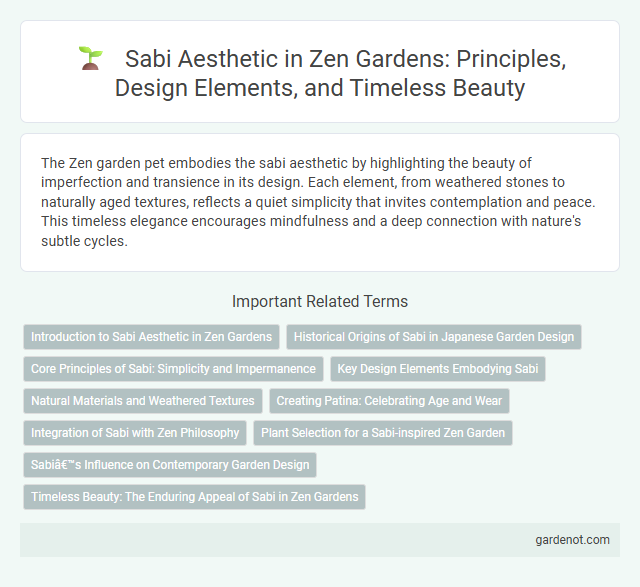The Zen garden pet embodies the sabi aesthetic by highlighting the beauty of imperfection and transience in its design. Each element, from weathered stones to naturally aged textures, reflects a quiet simplicity that invites contemplation and peace. This timeless elegance encourages mindfulness and a deep connection with nature's subtle cycles.
Introduction to Sabi Aesthetic in Zen Gardens
Sabi aesthetic in Zen gardens emphasizes the beauty of aging, imperfection, and natural simplicity. This principle highlights weathered materials, muted colors, and asymmetrical forms that evoke a sense of quiet solitude and timelessness. Rooted in Japanese philosophy, Sabi inspires mindfulness and deep appreciation for transient moments within garden spaces.
Historical Origins of Sabi in Japanese Garden Design
Sabi, a core aesthetic in Japanese Zen garden design, originated during the Muromachi period (1336-1573) as a reflection of impermanence and rustic beauty. Rooted in Zen Buddhist philosophy, Sabi emphasizes aged materials, weathered surfaces, and simplicity, promoting a profound appreciation for natural wear and decay. This historical concept shaped the minimalist and contemplative qualities that define traditional Japanese gardens today.
Core Principles of Sabi: Simplicity and Impermanence
The Sabi aesthetic in Zen gardens emphasizes simplicity, highlighting the beauty found in minimalism and natural wear. Core principles focus on impermanence, reflecting the transient nature of life through aged materials and weathered textures. This approach fosters a tranquil atmosphere, encouraging contemplation of the passage of time and the elegance of subtle decay.
Key Design Elements Embodying Sabi
Sabi aesthetic in Zen garden design emphasizes aged beauty through weathered materials, such as rustic stones and timeworn wood, symbolizing the passage of time and impermanence. Key design elements include asymmetry, muted natural colors, and simplicity, fostering a serene atmosphere that invites quiet reflection. The subtle integration of moss, rough textures, and minimalistic ornamentation embodies the poetic melancholy and tranquility central to Sabi.
Natural Materials and Weathered Textures
Sabi aesthetic in Zen gardens emphasizes the use of natural materials such as aged wood, stone, and weathered bamboo to evoke a sense of tranquility and timelessness. Weathered textures, including rough stone surfaces and moss-covered rocks, highlight imperfection and decay, reflecting nature's slow passage of time. This approach fosters a harmonious environment where simplicity and the beauty of natural aging are deeply appreciated.
Creating Patina: Celebrating Age and Wear
Sabi aesthetic in Zen gardens emphasizes the beauty found in patina, highlighting natural aging and weathering of materials such as stone, wood, and metal. Creating patina celebrates imperfection, evoking a sense of tranquility and timelessness through moss-covered rocks, rusted lanterns, and worn pathways. This deliberate wear enriches the garden's atmosphere, reflecting the transient nature of life and the serene passage of time.
Integration of Sabi with Zen Philosophy
Sabi, emphasizing beauty in imperfection and natural aging, aligns seamlessly with Zen philosophy's focus on mindfulness and simplicity. This aesthetic nurtures a profound connection to nature and the passage of time, encouraging quiet reflection within a Zen garden. Embracing Sabi cultivates an environment where tranquility and impermanence coexist harmoniously, enhancing the meditative experience.
Plant Selection for a Sabi-inspired Zen Garden
Plant selection for a Sabi-inspired Zen garden emphasizes species that evoke aged beauty and natural simplicity. Mosses, weathered pines, and grasses with subdued colors embody the wabi-sabi principles of imperfection and transience. Incorporating asymmetrical growth patterns and minimalistic foliage enhances the tranquil atmosphere, creating a timeless, serene landscape.
Sabi’s Influence on Contemporary Garden Design
Sabi's influence on contemporary garden design emphasizes the beauty of imperfection, aging, and subtle natural elements, fostering spaces that evoke tranquility and timelessness. Garden designers integrate weathered materials, asymmetry, and sparse compositions to reflect Sabi's principles, creating environments that encourage mindfulness and reflect the passage of time. This aesthetic prioritizes authentic simplicity and understated elegance, reshaping modern gardens into contemplative retreats.
Timeless Beauty: The Enduring Appeal of Sabi in Zen Gardens
Sabi, a core principle in Zen garden design, emphasizes the beauty found in imperfection, aging, and natural wear, reflecting a deep appreciation for timelessness and authenticity. The weathered textures of stones, moss-covered surfaces, and faded wooden elements evoke a sense of tranquility and contemplation that transcends fleeting trends. This enduring appeal of Sabi enhances the meditative quality of Zen gardens, inviting visitors to embrace the passage of time with mindfulness and grace.
Sabi aesthetic Infographic

 gardenot.com
gardenot.com